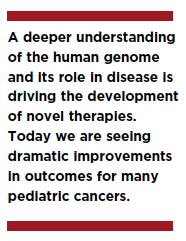This is an exciting time in medicine, providing more novel treatments for patients with cancer blood disorders. Scientists are learning more about the human genome and its role in disease. This knowledge allows investigators to develop new diagnostic tools and therapeutic interventions to more specifically treat individual diseases. We are now identifying ways to correct disorders characterized by single gene mutations.
Innovations in Clinical Development Yield Promising Results
New technologies, such as clustered regularly interspaced short palindromic repeats (CRISPR), allow scientists to excise a mutated gene and replace it with a non-mutated gene. Equally important, we are learning to harness the power of the immune system to treat cancer. We have learned that the human immune system can, in some cases, be tolerized to a patient’s malignant cells, so that it does not mount an immune response against the cancer, allowing the cancer cells to escape detection (and subsequent destruction) by the body’s immune system.
 New agents such as checkpoint inhibitors are showing promise in activating the patient’s immune response against the cancer. In addition, we are now developing new therapies that enhance the immune system response against cancer. Investigators are studying ways to alter hematopoietic cell grafts to alter the immunologic power of the grafts, leading to reduction of graft-versus-host disease or enhancement of anti-leukemia effects. In addition, cytotoxic T-cell therapies are increasingly utilized to treat post-transplant viral infections such as EBV and adenovirus. Natural killer (NK) cell infusions are being explored for their leukemia cell-killing abilities, especially in AML when the donor and recipient are killer immunoglobulin-like receptor (KIR)-ligand mismatched.
New agents such as checkpoint inhibitors are showing promise in activating the patient’s immune response against the cancer. In addition, we are now developing new therapies that enhance the immune system response against cancer. Investigators are studying ways to alter hematopoietic cell grafts to alter the immunologic power of the grafts, leading to reduction of graft-versus-host disease or enhancement of anti-leukemia effects. In addition, cytotoxic T-cell therapies are increasingly utilized to treat post-transplant viral infections such as EBV and adenovirus. Natural killer (NK) cell infusions are being explored for their leukemia cell-killing abilities, especially in AML when the donor and recipient are killer immunoglobulin-like receptor (KIR)-ligand mismatched.
CAR-T cell Therapy for Patients with ALL and NHL
Finally, CAR-T cells, T-lymphocytes from a patient are genetically modified to express a leukemia-specific antigen, are showing great promise in patients with ALL and NHL. The first CAR-T cell products are projected to be approved by the FDA later this year. As we learn more about each of these technologies, they can be expanded to other cancers. With all of these new therapies, physicians will need to learn how to best identify which patients will benefit, how to identify and treat the new toxicities, and how to incorporate those active agents into current treatment guidelines. Taken together, these novel immunotherapy interventions expand our armamentarium of weapons against cancer, complementing or replacing existing therapies, with the ultimate goal of reducing acute and long-term toxicities and increasing survival. l










